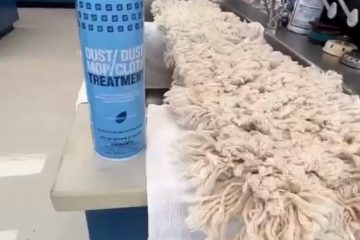Chlorine often gets a bad reputation, especially in the cleaning industry. It’s often stigmatized for toxic and corrosive qualities, a pungent smell and irritating effects to the eyes and respiratory system. In fact, the U.S. Environmental Protection Agency (EPA) won’t even consider any products containing chlorine for its Safer Choice certification program.
While it’s true that chlorine gas can be poisonous, in other forms it can be very helpful to society—it kills bacteria, is used to treat drinking water, and sanitizes swimming pool water. When used correctly and in proper forms, it can be extremely beneficial to humanity. Having both positive and negative qualities is true for many elements. For example, oxygen, which most people wouldn’t even question its safety, can be a corrosive and highly unstable gas that can damage cell membranes. Chlorine is the teenager of the periodic table. It is often misunderstood. Before immediately judging chlorine-related products as toxic cleaning agents, it’s important to understand this versatile element and its different forms and roles.
Chlorine and Chloride 101
Chlorine is one of the most widely used chemicals in different forms. In 2021, the worldwide market volume of chlorine was 92.3 million metric tons, and is forecasted to grow to 123 million metric tons by 2029. An integral part of our lives, it is used for products and applications that many people may not realize including insecticides, pharmaceuticals, cleaning products, textiles and plastics.
Chlorine (Cl), atomic number 17, is a member of the halogen family on the periodic table. It is a yellow-green gas at room temperature, and the second lightest of the halogen elements. Elemental chlorine does not exist naturally in nature and is found only in compounds with other chemical elements. It is extremely reactive with metals and can also form salts. This happens because halogens have seven outer ring electrons, but need eight in order to form a stable configuration. Just like many teenagers, chlorine doesn’t act alone – it must combine with a friend or foe in order to produce healing or harmful qualities.
The most common chlorine compounds are chlorides, which can be salts with chlorine in them or acids such as hydrochloric acid (HCl). This includes sodium chloride (NaCl), commonly known as table salt. Chlorides can cause corrosion on materials such as aluminum and stainless steel, which is why many people equate chlorine as being corrosive, when in fact corrosion is caused by more potent chlorides such as magnesium chloride. Interestingly, chlorides are also essential for human survival, as it is one the major minerals in the human body. They play a critical role in bodily functions for nerve health, muscle contraction, digestion, oxygenation, and blood pressure regulation. With the different roles that chlorine and chlorides play in human health and common products like table salt, it’s time to take a closer look on a case-by-case basis before immediately jumping to safety conclusions with chlorine-related products.
A Chlorine-Based Disinfectant Used for Surfaces and Skincare?
Did you know that there is a non-toxic, chlorine-derived disinfectant that is strong enough to kill bacteria and viruses, yet gentle enough to use in skin care products? Hypochlorous Acid (HOCl), nature’s original disinfectant, is a weak acid that is formed when chlorine dissolves in water. While the acid may be weak, it is very powerful against pathogens, yet a low-risk disinfectant to the user. Research has even revealed that using hypochlorous acid as a disinfecting solution is 80–200 times more effective than bleach in bacteria surface disinfection yet is nontoxic to humans. In its Safety Data Sheet (SDS), no first aid measures are required for inhalation, skin contact, eye contact and ingestion. This is an extremely dramatic difference than its brother and sister cleaning chemical counterparts that warn of severe breathing difficulties, vomiting, pneumonia, and fluid in the lungs if inhaled or ingested—proving that not everything generated from chlorine is toxic.
Fascinatingly, hypochlorous acid occurs naturally in the body. It is created by white blood cells to fight off infection, bacteria and skin injury. While the body creates it naturally, organizations can generate hypochlorous acid for surface disinfection purposes easily on-site using electrochemical activation (ECA) technology. This enables businesses to produce the optimal amount of disinfectant for cleaning purposes on-demand. Using the approach that less is more, with just salt, water and electricity, the system outputs ready-to-use concentrations of hypochlorous acid sanitizer that is strong enough to kill 99.9% of virus and bacteria, yet non-toxic to protect the health of cleaners and building patrons.
Chlorine is a remarkable element that has the power to become extremely helpful or lethal based on its form and what is combined with. Just like a teenager thrives when making good decisions, chlorine thrives when turned into hypochlorous acid. It allows businesses to make good on their business promises and provide a safe, clean and non-toxic environment using a responsible cleaning solution with just three simple ingredients. The next time you come across a product that originates from chlorine, be sure to do your research to understand its role before jumping to conclusions.
The post Chlorine: Debunking the Myths of a Misunderstood Element appeared first on ISSA.


0 Comments